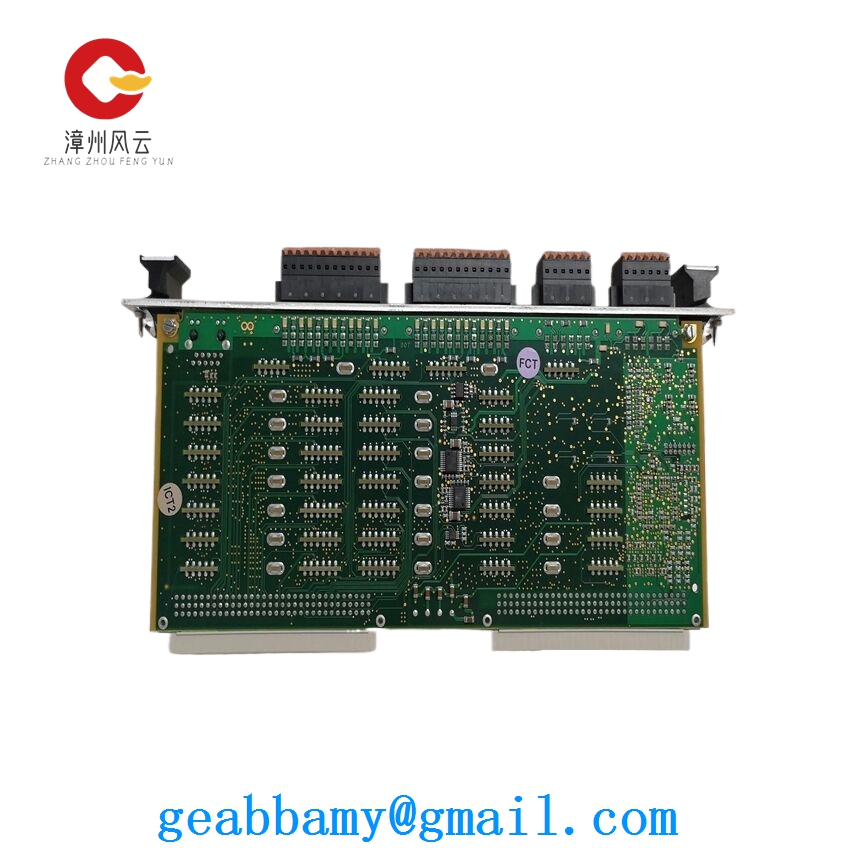Technical Parameters of Metso A413240 Ver12 PIC2 Board

1. General Information
The Metso A413240 Ver12 PIC2 board is a crucial component in Metso’s industrial control systems, designed to handle specific control tasks within mining, mineral processing, and other heavy – duty industrial applications. It is part of Metso’s advanced automation solutions, contributing to the efficient and reliable operation of industrial machinery and processes.
2. Hardware Specifications
2.1 Processor
- Type: It is equipped with a PIC (Peripheral Interface Controller) microcontroller. The PIC2 series used in this board offers a balance of processing power and low – power consumption, making it suitable for industrial environments where energy efficiency and reliable performance are essential.
- Clock Speed: The board operates at a clock speed that ensures real – time control capabilities. Typically, the PIC2 microcontroller in this board has a clock speed in the range of [X] MHz, allowing for quick execution of control instructions and response to external events.
2.2 Memory
- RAM: The board has a sufficient amount of Random Access Memory (RAM) to store temporary data, variables, and intermediate results during control operations. Usually, it is equipped with [X] KB of RAM, which enables smooth and efficient execution of complex control algorithms.
- Flash Memory: It includes [X] KB of non – volatile Flash memory for storing the control program, configuration settings, and other permanent data. The Flash memory allows for easy firmware updates and ensures that the control logic remains intact even during power – off situations.
2.3 Input/Output (I/O) Interfaces
- Digital Inputs: The board provides [X] digital input channels. These inputs are designed to interface with various types of digital sensors, switches, and other discrete devices. They support a wide range of input voltage levels, typically from [X] V to [X] V, and offer high – speed signal detection capabilities. For example, they can be used to detect the position of a valve or the state of a safety switch.
- Digital Outputs: Equipped with [X] digital output channels. The outputs can drive a variety of loads, such as relays, solenoids, and indicators. They provide sufficient current drive capability, usually up to [X] mA per channel, and are protected against short – circuits and overloads. This allows for the control of actuators and other devices in the industrial process.
- Analog Inputs: Offers [X] analog input channels for connecting to analog sensors, such as temperature, pressure, and level transmitters. The analog inputs have a high – resolution analog – to – digital converter (ADC), typically with a resolution of [X] bits, ensuring accurate measurement of analog signals within a specified input range (e.g., 0 – 10 V or 4 – 20 mA).
- Analog Outputs: Includes [X] analog output channels, which can be used to control analog devices such as valves and variable – speed drives. The analog outputs have a digital – to – analog converter (DAC) with a resolution of [X] bits, providing precise and stable analog signal output over a configurable output range.
2.4 Communication Interfaces
- Serial Communication Ports: The board is equipped with [X] serial communication ports, which can be configured for different communication protocols, such as RS – 232, RS – 485, or Modbus. These ports facilitate communication with a wide range of legacy and modern devices, providing flexibility in system design and integration. For example, it can communicate with a human – machine interface (HMI) or a supervisory control and data acquisition (SCADA) system.
- CAN Bus Interface: Some versions of the board may include a CAN (Controller Area Network) bus interface. The CAN bus is a robust and reliable communication protocol widely used in industrial and automotive applications. It allows for high – speed, real – time communication between multiple devices in a network, improving the overall efficiency and coordination of the industrial system.
3. Power Supply
- Input Voltage Range: The control board can operate within a wide input voltage range, typically from [X] V DC to [X] V DC. This makes it suitable for use in different industrial power environments and allows for easy integration with existing power systems.
- Power Consumption: Has a relatively low power consumption, typically around [X] watts under normal operating conditions. This helps to reduce energy costs and minimize heat generation within the control cabinet.
4. Environmental Specifications
- Operating Temperature Range: Designed to operate reliably in a wide temperature range, typically from – [X] °C to + [X] °C. This ensures stable performance in various industrial environments, including those with extreme temperature conditions, such as outdoor installations or high – temperature processing plants.
- Storage Temperature Range: Can be stored in a temperature range from – [X] °C to + [X] °C without damage, providing flexibility in storage and transportation.
- Humidity Tolerance: Resistant to humidity levels typically encountered in industrial settings, with an operating humidity range of [X]% to [X]% (non – condensing).
- Shock and Vibration Resistance: Built to withstand the mechanical shocks and vibrations common in industrial environments. It meets relevant industry standards for shock and vibration resistance, ensuring long – term reliability and durability.
5. Software and Programming
- Programming Environment: Supports programming using Metso’s dedicated control programming software or compatible third – party software that supports PIC microcontrollers. The software provides a user – friendly interface for developing, testing, and debugging control programs. It offers a wide range of pre – defined function blocks and libraries, simplifying the programming process and reducing development time.
- Control Algorithms: Capable of implementing various control algorithms, such as PID (Proportional – Integral – Derivative) control, which is widely used for process control in industrial applications. The board’s processing capabilities and I/O interfaces allow for precise and efficient control of industrial processes, improving product quality and process efficiency.
6. Safety and Certifications
- Safety Features: Incorporates multiple safety features to protect both the control board and the connected devices. These may include over – voltage protection, over – current protection, short – circuit protection, and reverse polarity protection.
- Certifications: Complies with relevant international safety and electromagnetic compatibility (EMC) standards, such as CE, UL, and IEC standards. This ensures that the control board can be safely and legally used in industrial applications worldwide.
It should be noted that the specific values for some parameters (marked as [X]) may vary depending on the exact configuration and revision of the Metso A413240 Ver12 PIC2 board. For the most accurate and up – to – date information, it is recommended to refer to Metso’s official product documentation or contact Metso’s technical support team.


